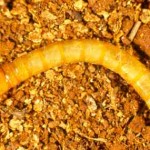False wire worms (FWW)
- Grey false wireworm (Isopteron puctatissimus)
- Bronze field beetle (Adelium brevicorne)
- Gonocephalum sp
- Pterohelaeus sp
| Objectives | Pre sowing | Seedling |
|---|---|---|
Insects and damage |
Where to find them
It is possible to inspect a paddock into which canola will be planted the following autumn in spring (September) when fully grown larvae are most visible. Use the same technique for sampling soil for larvae immediately prior to sowing. |
Damage
Damage is more severe when germination and establishment of newly sown crops is impaired by cold and wet, or dry conditions. |
| Monitoring | Count the number of larvae in a quadrat (30x30cm) of soil to 2 cm depth (deeper if soil moisture is deeper). Repeat at 5-10 sites in the field.
Germinating seed baits can be used to monitor for the presence of false wireworm. See monitoring for soil insects for more detailed information. |
Inspect areas of poor establishment for characteristic damage to seedlings. Look for signs of damage above ground, and for beetles sheltering in the soil and under stubble.
Occasionally adult beetles (Gonocephalum and Pterohelaeus) can move across emerging crops grazing on cotyledons and terminals. |
| Natural enemies | Carabid beetle larvae feed on soil dwelling insects including false wireworm but their numbers are rarely sufficiently high to control populations. | |
| Cultural control |
|
|
| Thresholds | The thresholds for false wireworm vary and are speculative:
|
|
| Chemical control | Insecticide control is recommended if the threshold is exceeded.
Impact on beneficial insects The use of soil-incorporated insecticides (e.g. OPs) for FWW control will have a significant impact on other insects in the soil. These include not only beneficial insects that predate directly on FWW e.g. carabid beetles, but also on those that predate other species like earthmites. |
|
| Multi-pest considerations | Other pests e.g. earthmites can also affect crop establishment. Careful monitoring is critical to attribute seedling loss/damage to the correct cause and implement the appropriate management. | |
| Communication |
|
|
Further information
- Diagnosing false wireworm (Agriculture WA)
- Wireworm species (cesar PestNotes)
- Cesar pestfacts 2010
- Cesar pestfacts 2011
- False wireworm (DAF Queensland)
